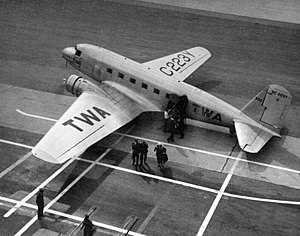Douglas DC-1
| DC-1 | |
|---|---|
 |
|
| Douglas DC-1 on its handover to TWA in December 1933 | |
| Role | Prototype and Testbed |
| Manufacturer | Douglas Aircraft Company |
| First flight | July 1, 1933 |
| Introduction | December 1933 |
| Status | Destroyed |
| Primary user | Transcontinental & Western Air |
| Number built | 1 |
| Developed into | Douglas DC-2 |
The Douglas DC-1 was the first model of the famous United States DC (Douglas Commercial) commercial transport aircraft series. Although only one example of the DC-1 was produced, the design was the basis for the DC-2 and DC-3.
Development of the DC-1 can be traced back to the 1931 crash of TWA Flight 599, a Fokker F.10 Trimotor airliner in which a wing failed, probably because water had seeped between the layers of the wood laminate and dissolved the glue holding the layers together. Following the accident, the Aeronautics Branch of the U.S. Department of Commerce placed stringent restrictions on the use of wooden wings on passenger airliners.Boeing developed an answer, the 247, a twin-engined all-metal monoplane with a retractable undercarriage, but their production capacity was reserved to meet the needs of United Airlines, part of United Aircraft and Transport Corporation which also owned Boeing. TWA needed a similar aircraft to respond to competition from the Boeing 247 and they asked five manufacturers to bid for construction of a three-engined, 12-seat aircraft of all-metal construction, capable of flying 1,080 mi (1,740 km) at 150 mph (242 km/h). The most demanding part of the specification was that the airliner would have to be capable of safely taking off from any airport on TWA's main routes (and in particular Albuquerque, at high altitude and with severe summer temperatures) with one engine non-functioning.
Donald Douglas was initially reluctant to participate in the invitation from TWA. He doubted that there would be a market for 100 aircraft, the number of sales necessary to cover development costs. Nevertheless, he submitted a design consisting of an all-metal, low-wing, twin-engined aircraft seating 12 passengers, a crew of two and a flight attendant. The aircraft exceeded the specifications of TWA even with two engines, principally through the use of controllable pitch propellers. It was insulated against noise, heated, and fully capable of both flying and performing a controlled takeoff or landing on one engine.
...
Wikipedia
